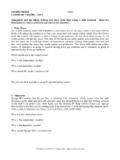Transcription of Paper 69-27 What’s In A Name; Describing SAS File …
1 Paper 69-27 What s In A Name; Describing SAS File types Randall Cates, Technical Training Specialist 3 SAS Institute Inc., St. Louis Training Center ABSTRACT Are you confused by the different types of SAS files in your libraries? Need a scorecard? If a file has the type .SAS7 BDAT that s a SAS dataset, right? So how is a type .SAS7 BVEW different? Or is it different? If you can send a SAS dataset (.SAS7bdat) to another SAS programmer, why can t you do the same with a .SAS7 BVEW? What s a MDDB? An Item Store file? There are a number of different types of SAS files available to the SAS programmer. The SAS dataset is the most familiar, but many programmers also use SAS Views, SAS Catalogs, But each one stores something different. You can possibly find many if not all file types in your company s SAS libraries. This Paper will review for the beginning SAS programmer all the different file types , how to use them to best effect, and will present some ideas for better file management.
2 First we will discuss each different file type, starting with the SAS dataset, and talk about what it stores, and how you can access and use it. For example, the SAS catalog has the file type of .SAS7 BCAT, and it can store a number of items including sas code(both compiled and text) macros, and formats. Depending on what it stores you might want to keep each catalog in a specific library, or all catalogs in one. INTRODUCTION The SAS system contains a veritable rainbow of different file types . However, the average SAS programmer only uses four or five primary file types ; the SAS program, SAS dataset, SAS log, SAS Listing, with an occasional stab at a SAS catalog or a SAS index file. This Paper will present an overview of most of the different files that are available, where they exist, and how they are used in SAS programming. SAS file types discussed are: Program files Log files Listing files Datasets Data views Catalogs Indexes Audit files Stored programs Dictionary tables Item stores Multidimensional databases.
3 SAS Libraries and SAS I/O engines will also be reviewed. In addition, certain other SAS products use different file structures. For example, IT Service Vision uses Performance Databases (PDBs), CFO Vision uses Financial Databases (FDBs), and Enterprise Guide uses Project files. This Paper will not cover these specialty file structures. This presentation is intended as an Introduction to SAS file types and will not attempt to cover all aspects of any particular file type. Focus will be on files as they exist on MS-Windows operating systems. SAS FILE types SAS file types can be separated into two types of files, whether they are visible in a SAS library or not. Files that are visible in a library are: datasets, data views, catalogs, stored programs, dictionary tables, and multidimensional databases. Files that are not visible in a library are: program files, log files, listing files, engines, indexes, audit files, and item stores.
4 We will begin our tour by looking at SAS libraries. SAS LIBRARIES A SAS data library is defined as a collection of one or more SAS files that are recognized by the SAS system and that are referenced and stored as a unit. Therefore, a SAS library is not a file. Instead it s a way of looking at a bunch of SAS files as a group, instead of a lot of individual files. Usually a library corresponds to all of the appropriate SAS files in a particular subdirectory. The SAS system uses the LIBNAME statement to set up a SAS library and define the pathname(s) of the SAS files. For example: LIBNAME mydata C:\My Data\SUGI27 ; Now, the programmer or program has access to any SAS files at that location just by using the library reference, in this case mydata . PROC CONTENTS DATA= nods; Run; The above code prints out a report of the names and file types of all SAS files in the Mydata library.
5 When the SAS system is started, either through Batch processing or Interactive Windowing modes, it automatically sets up a set of libnames; the WORK, SASHELP, and SASUSER libnames. These libraries each have special functions. The SASHELP library consists of a combination of numerous subdirectories and contains links to catalogs and other SAS files. Some of these files contain information used to control various aspects of the SAS session. This library is also where you can find the files that the Help menu accesses. The defaults stored in this library are for everyone using SAS at your installation. SUGI 27 Beginning TutorialsThe SASUSER library contains SAS files that enable each programmer to tailor their session to their own separate requirements. For example, if you wish to set up and use a different set of Fkey commands than the default set, your list of commands are stored in a catalog file here.
6 You may also want to store some files that you use all the time here. The SASUSER library can also be used to store user-defined formats that you access frequently but that are not part of your company s collection of valid formats. Formats will be discussed further in the Catalogs section. The WORK library is a temporary scratch repository. It stores any temporary files that you create and any temporary files that SAS creates during the processing of the session. The SAS system creates a new directory for this each time a SAS session is initiated, and is deleted at the end of the SAS session. Whenever you create a SAS data set using just one name, it defaults to the Work library. For example: DATA test; Is interpreted by the SAS system as: DATA ; If you would like to specify a Permanent library to be the default repository you can set up a USER library using a standard LIBNAME statement.
7 For example: DATA USER D:\My Temp Files ; After this statement, whenever a one-level file is mentioned in the code, the SAS system will interpret it to mean the USER library. The WORK library is still available, but you now need to explicitly specify it. SAS I/O ENGINES Engines are not strictly files, but are sets of internal instructions that SAS uses to read from and write to files. Engines form a access path between the SAS system and the data. For example, you can use the Oracle LIBNAME engine to transparently access data stored in an Oracle database. The LIBNAME statement would look like this: LIBNAME myoracle ORACLE user=me pw=mypasswd Path=dbmssrv schema=special; The name of the library is Myoracle. Everything else in the LIBNAME statement are instructions to the SAS system to control access to the Oracle database. The word ORACL tells SAS to use the Oracle engine.
8 The engine has all the instructions inside it enabling it to locate the files and bring the data into the SAS workspace in a clear and usable form. The files that enable this particular engine belong to the SAS/ACCESS to ORACLE product. When accessing directories containing SAS data files, usually you do not have to specify what types of SAS files are contained there. The SAS system will choose the appropriate engine for you. When you submit the LIBNAME statement accessing (for example) a directory containing SAS Version 8 files, the SAS system identifies the files there as V8 files and accesses the V8 engine. The Log will contain a note that specifies engine the SAS system has assigned to the library. SAS PROGRAMS, LOGS, AND LISTINGS Program, log, and listing files are probably the most frequently used files in the SAS system. They are all structured as text files, in that programmers can use any Text Editor to open, peruse, and edit them.
9 They are, however separated from other text files by their extensions. Program files usually have a .SAS extension, Log files have a .LOG extension, and Listing files have a .LST extension. Figure 1 shows how these three files look in MS-Windows Explorer. These types of files will not be seen through a library, even if the library accesses a directory containing these files. Fig. 1 SAS file type Icons Programmers create program files. As the name implies, the program file contains SAS code that directs SAS to fulfill some data processing task(s). Log files are created as a result of a program file being submitted to the SAS system for execution, most usually by the Batch programming method. However, when a programmer working in interactive SAS saves the contents of the Log Window, the default type of the file is also .LOG. The log file contains the program code that was submitted as well as notes, error messages and warning messages that describe how the SAS system processed the program code.
10 Listing files are also created as a result of a program file being submitted to the SAS system. However, the listing file is only created as a result of program code that generates some type of report. If the code doesn t request (for example) a PROC PRINT, or worse yet, has errors that prevent a report from being created, the listing file is not created. SAS DATA SETS The SAS data file (or dataset) stores data. Probably for most SAS programmers the SAS dataset is the storage option of choice. The SAS dataset has a .SAS7 BDAT extension (See ). Fig. 2 SAS Data set icon The SAS dataset stores character and numeric data in the form of a 2-dimensional table of discrete observations and variables. The observations correspond to the rows of a table and consist of all the stored information about one entity of choice. The variables correspond to the columns of a table and each consists of all discrete data points for one item of interest.















